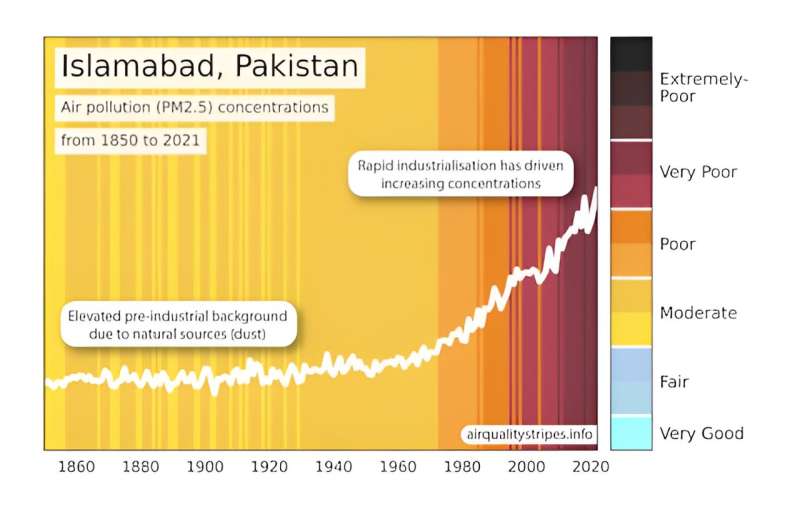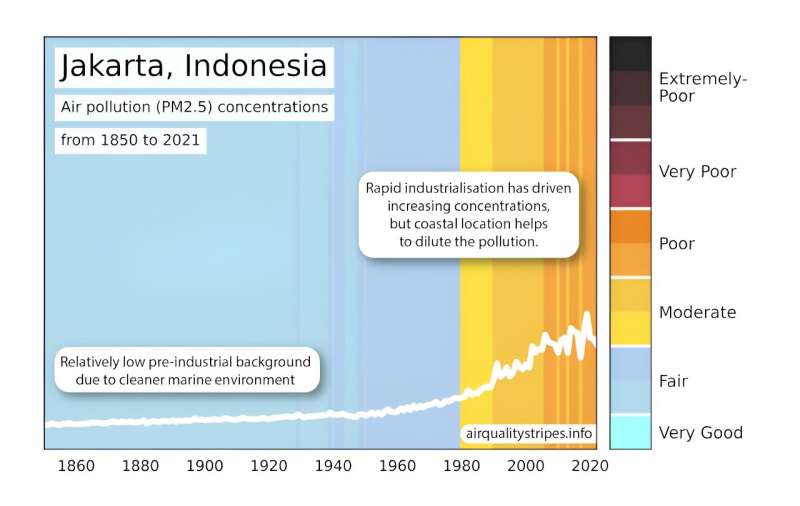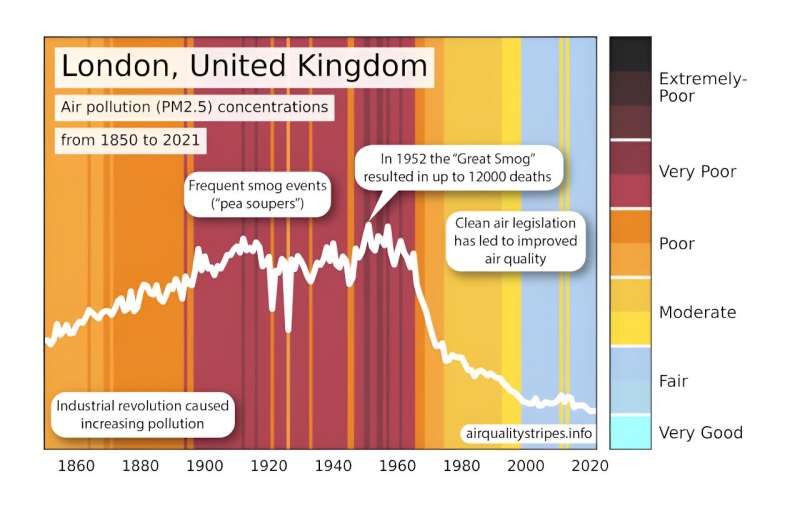This article has been reviewed according to Science X's editorial process and policies. Editors have highlighted the following attributes while ensuring the content's credibility:
fact-checked
trusted source
written by researcher(s)
proofread
These colorful diagrams show how air quality has changed in more than 100 countries since 1850

Air pollution is an unseen menace that poses a major threat to human health and the climate. We have created the air quality stripes, a visual tool that captures global air pollution trends, to bring this hidden threat into sharp focus.
Inspired by professor of climate science Ed Hawkins' climate warming stripes, the air quality stripes depict particulate matter (PM) concentrations in 176 cities worldwide since 1850. These tiny particles, often smaller than one-30th of the width of a human hair, can penetrate deep into the lungs, posing serious health risks.
By making air pollution more visible, the stripes provide a clear way to understand how air quality has evolved over time across different regions.
These new stripes reveal a stark contrast between significant improvements in air quality across Europe and alarming deterioration in parts of Africa and central Asia. Cities like London, Brussels and Berlin are represented by lighter blue stripes, indicating substantial reductions in PM levels. This progress reflects stricter air quality regulations and advancements in reducing emissions.
Conversely, cities in central Asia and Africa, such as Islamabad, Delhi and Nairobi, are depicted by darker hues, reflecting a worrying rise in pollution. Rapid urbanization, industrial growth and limited regulations are worsening air quality issues in these regions, while people living in poorer areas are often exposed to higher concentrations of pollution.
In 2021, the World Health Organization issued new guidelines for air quality, revealing that over 99% of the global population lives above recommended levels. The air quality stripes clearly outline the urgent need for targeted international efforts to address this pollution crisis.

Creating the air quality stripes involved more than just illustrating trends—it involved capturing the complexity of air pollution. PM originates from both natural and human-made sources.
Natural contributors, such as desert dust, wildfires and volcanic activity predate the industrial revolution. Human activities like industry, agriculture and vehicle emissions are significant contributors, particularly in urban areas.
We observed the influence of natural sources in certain regions. For example, coastal cities like Jakarta show lower particulate levels than expected, likely due to sea breezes. Conversely, regions near deserts or with frequent wildfires often show higher PM concentrations, reflected by darker stripes.
Between 1990 and 2021, deaths caused by PM increased by 93%. As other factors affecting mortality improve, air pollution becomes an increasingly critical issue.
One compelling aspect of the air quality stripes is their historical reach. We combined data from computer simulations and satellite observations to estimate PM concentrations back to the industrial revolution. This long-term perspective is crucial for understanding how human activity has shaped air quality over the centuries.
However, this historical analysis presented challenges. Early data is sparse and often anecdotal. For instance, we drew insights from an analysis of Claude Monet's paintings, which depict the smog-laden skies of London in the late 19th and early 20th centuries.

These artistic interpretations provide valuable context but also highlight the limitations of early air quality records. While we now have literally millions of observations from satellites detailing levels of pollution and the weather patterns that transport them around the world, these are only relatively recent.
For early data points, we have to rely upon historical emissions inventories as starting points to estimate annual PM concentration profiles. These databases are used to simulate the current generation of climate models.
The color of pollution
A key challenge was choosing a color scheme that accurately represented the data. We chose a gradient from light blue to black. Light blue represents clean air, while black indicates high levels of pollution. We collaborated with a visualization expert, Ethan Brain, who analyzed more than 200 online images with the "air pollution" tag to identify the most appropriate color palettes.
The resulting visual tool is both scientifically accurate and easy for everyone to understand. Richard Rigby, a research software engineer from the Center for Environmental Modeling and Computation at the University of Leeds, helped bring the stripes to life through an interactive website. The stripes distill complex data into a format that is instantly recognizable, helping to raise awareness about the global state of air quality.
The air quality stripes are more than just a data visualization. They are a call to action. By making air pollution visible, we hope to highlight progress and confront ongoing challenges. The stark contrasts between regions remind us that there are major environmental inequities. While some parts of the world are breathing easier, others face an increasingly toxic environment.
The transition to net zero hinges on moving away from using fossil fuels for transport and power generation. That will also dramatically improve air quality.
Provided by The Conversation
This article is republished from The Conversation under a Creative Commons license. Read the original article.![]()




















